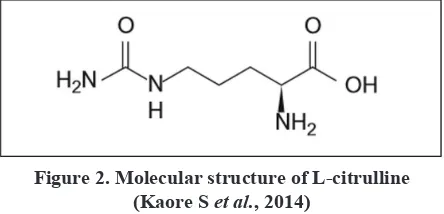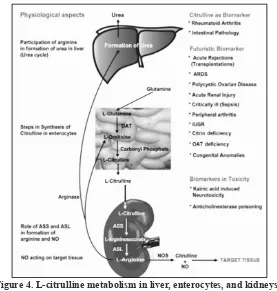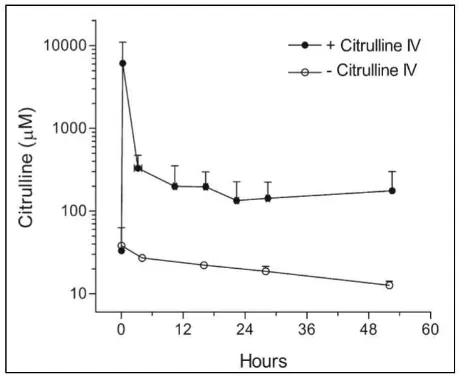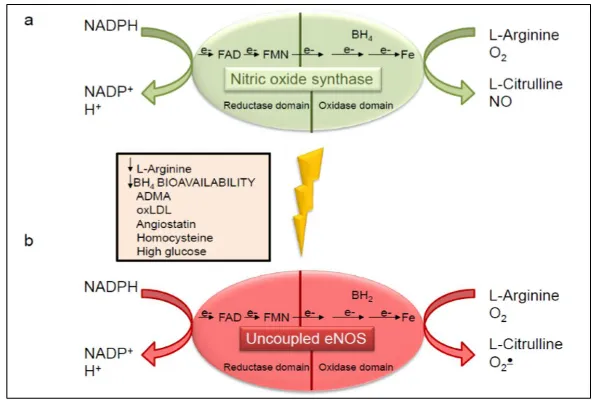Received: February 2018 Revised: June 2018 Accepted: August 2018 ARTICLE HISTORY
world. Prevalent attempts of physicians to treat this disease came down to focus on using drugs with their specific mechanism of action. Since the method only cures the symptoms and need to be pharmacologically monitored, physicians and scientists have been strug-gling to find other treatment strategies. This problem led us to search for another substance dealing with CVD via preventive therapy, which does not require such close monitoring by physicians in its use. The answer relies on using L-citrulline as potential therapeutics in treating and preventing CVDs. This compound, found mostly in Citrus sp., contains chemical traits that could affect other bodily substances with its metabolic pathways. It has several functions, but boosting NO production is the dominant one in the cardiovascu-lar system. By enhancing NO bioavailability, it suppresses the risk of having myocardial oxidative stress due to ischemia, cardiac pressure-overload, and post-infarct reperfusion. Thus, understanding of L-citrulline effects on endothelial NOS pathway in the generation of NO and its uncoupling mechanisms could be used as a foundation in developing alter-native treatment and prevention of oxidative stress-induced CVD.
Keywords: cardiovascular; l-citrulline; nitric oxide; oxidative; treatment *corresponding author
Email: laurentiusandrea@gmail.com
INTRODUCTION
Cardiovascular disease (CVD) has been the most common
nationwide cause of death. It accounts for average
30% ultimate cause of death in both developed and
developing countries. The era of rapid industrialization and urbanization has promoted higher emergent of the
diseases, with some examples such as pathological cardiac hypertrophy, myocardial infarction, and cardiac valve lesions. Risk factors increasing probability of
suffering CVDs include the molecular scope of genetics
into wide exposure of environmental factors(Loscalzo
& Harrison, 2013).
Physicians’ attempts to relieve CVDs have come down
into usage of specific pharmacological strategies, such as
antihypertensive agents or diuretics. Although they are often deployed to treat CVDs with such low therapeutic index, their amounts in blood plasma must be controlled
very carefully to minimize any adverse effects (Katzung
et al., 2015). Since the method only cured symptoms
and needed to be pharmacologically monitored,
physicians and scientists have been struggling to find other treatment strategies. This problem led us to search
for another substance dealing with CVD via preventive therapy, which does not require such a close monitoring
by physicians in its use. The proximate and ultimate answer for these problems is yes. It is L-citrulline. L-citrulline is known to have potential therapeutics in relieving CVDs. Following discussions of L-citrulline
are explained further into its molecular structure, biochemistry, pharmacology, physiology, as well as its
utilization in treating cardiovascular system.
L-citrulline is a non-essential amino acid classified specifically as a non-protein monomer (Kaore & Kaore, 2014). It means that L-citrulline cannot be used as raw
material in cellular protein synthesis, except that it
emerges as post-translational modification or Golgi’s products. L-citrulline does not charge with tRNA
normally as it does not correspond within the known 20 types of amino acids. Moreover, it is discovered in muskmelons, squashes, gourds, cucumbers, and pumpkins, as well as watermelons. Watermelons or
Citrus vulgaris are the ones contain lots of L-citrulline,
which constitutes approximately 2.1 mg per gram of fresh weight (Frank et al., 2017). Schematic representation of
watermelon functions can be seen in Figure 1.
L-citrulline may serve as antioxidant that prevents DNA
damage-induced oxidative stress and reticuloendothelial
system over activity. L-citrulline could also enhance
muscle protein synthesis, reduce gastrointestinal tract injury during exercise, and improve
blood-tissue perfusion. In this review, focus of L-citrulline
activities would be in the cardiovascular system. Any
supplementation of L-citrulline for human could be
obtained through chemical industries, genetically
modified microorganisms, or enzymatic reaction (Jiang
Figure 1. Watermelon (Citrus vulgaris) contains citrulline that promotes vasodilation, antioxidation, anti-inflammation, and healthy hepato-hematological functions Hong M et al., 2015. COX-2: cyclooxygenase 2, CRP: c-reactive protein, CVD: cardiovascular disease, HDL: high density
lipoprotein, LDL: low density lipoprotein, NO: nitric oxide, NOS: nitric oxide synthase, RelA: NF-kappa-B p65 subunit, TC: total cholesterol, TG: triglyceride
Biochemistry of L-citrulline
Chemical Characteristics of L-citrulline
L-citrulline is a non-protein amino acid with C6H13N3O3
alpha-structured configuration withmolecular mass 175.19 Dalton. Its high solubility in water makes it
perfect for oral administration via aqueous solution.
Available in white powder form and alkalized-smell,
its natural structure is often discovered in levorotatory
stereoisomerization. Considering its hydrophilic custom, high intake of L-citrulline orally might cause osmotic diarrhea (Kaore & Kaore, 2014). Molecular structure of
L-citrulline can be seen in Figure 2.
Metabolism and Biosynthesis of L-citrulline
L-citrulline is biosynthesized through nitric oxide and
urea cycles. Urea cycle covers up to 90% production of
L-citrulline in hepatocytes (Franket al.,2017).Arginine
is first transformed into ornithine by arginase, releasing
urea into blood plasma to be further cleared via kidneys
(Kaore & Kaore, 2014). Ornithine then combined with
carbamoyl phosphate as constituents of ammonia to
form citrulline by the enzymatic activity of ornithine
carbamoyltransferase (Frank et al., 2017). Besides,
citrulline could be metabolized back into arginine using
argininosuccinate as intermediates by argininosuccinate synthase and lyase(Mori et al., 2015).
Another process involved in the generation of
L-citrulline is the nitric oxide cycle in blood vessels Figure 2. Molecular structure of L-citrulline
(Kaore S et al., 2014)
which covers up 10% production of plasma L-citrulline
(Franket al., 2017). Direct transformation of arginine into citrulline using nitric oxide synthase gives out NO into plasma. Reverse metabolism from citrulline into arginine is associated with the same pathway using
argininosuccinate as biosynthetic intermediate (Jiang et al., 2017). In double-blind randomized research
cross-over design, supplementation of L-citrulline could
remove any excess ammonia accumulation in blood, alleviating any central fatigue in athletes (Chen et al.,
2016). Detail schematic metabolism of L-citrulline can
be seen in Figure 3 and 4.
Although nitric oxide cycle only constitutes tiny part
of L-citrulline production, it gives the biggest point of information regarding mechanisms of L-citrulline towards cardiovascular system. Studies conducted to
prove this hypothesis explained that consumption of
Citrus vulgaris regularly would resist cellular damage due to its antioxidative activity. As Citrus sp. elevates
plasma concentration of L-citrulline, it encourages the
bioavailability of NO gas throughout systemic and
pulmonary blood vessels. This condition provide basis for applying L-citrulline in promoting cardiovascular
health(Hong et al., 2015).
Physiological Mechanisms of L-citrulline in Cardiovascular System
L-citrulline: Nitric Oxide Production Booster
NO is a rapidly diffusing gaseous molecule that is
released at several locations, such as vascular endothelial
cells, neurons, and glial cells. It acts as vasodilator by
relaxing vessels’ smooth muscle. Production of NO gas
is done by nitric oxide synthase using L-arginine as primary substrate in the NO cycle. L-citrulline, in this
NO cycle, could be in paradoxical functions: precursor of
L-arginine or byproducts of L-arginine metabolism while
of L-citrulline orally increases plasma concentration of L-arginine. Additionally, arginine is then metabolized
back into citrulline via either urea or nitric oxide cycle
(Kurauchi et al., 2017). Beside the use of L-citrulline
as single agent, the combination of L-arginine and L-citrulline supplementation would further increase the amount of plasma citrulline (Suzuki et al., 2017). Metabolic balance manages the whole concentration of
arginine and citrulline itself in blood plasma. Graphical presentation between L-citrulline administration and
amount of plasma citrulline is explained in Figure 5.
In vascular endothelium, NO is released by endothelial nitric oxide synthase (eNOS) involving L-arginine and L-citrulline as substrate and product respectively (Incalza
et al., 2017). Adequate L-citrulline supplementation gradually activates NO production due to recycling of
L-citrulline into L-arginine.As a result, L-citrulline
Figure 3. L-citrulline in metabolic pathways: urea and nitric oxide cycle (Frank et al., 2017).
Figure 4. L-citrulline metabolism in liver, enterocytes, and kidneys. Note that L-citrulline could be used as biomarker (Kaore et al., 2014).
would indirectly increase NO levels in plasma (Mori
et al., 2015).Furthermore, NO does not exist long
enough in plasma soon after its release. Its maximum distance of diffusion is 300 µm with half-life of 0.05-1.8
milliseconds (Mori et al., 2015). Relationship between L-citrulline and plasma NO is explained in Figure 6.
Effects of L-citrulline on Plasma Amino Acids and
other Substances
Not only L-citrulline increase nitric oxide levels in blood, but also it reduces plasma GSH which then dramatically
decrease the degradation of NO by oxidation.As a matter of fact, serum nitrite (NO2-) concentration elevate significantly (Frank et al., 2017). NO2- ion would be
reduced to become NO under ischemic condition (Kaore
& Kaore, 2014).Furthermore, L-citrulline affects certain
substances in plasma; for example, glutamine, ornithine,
Figure 5. Plasma concentration-time profile of citrulline followed by continuous intravenous infusion after citrulline bolus administration. For comparison, citrulline plasma levels under similar
procedures without citrulline treatments (Barr F et al., 2007).
Figure 6. Plasma concentration-time profile of nitric oxide followed by continuous intravenous infusion after citrulline bolus administration. For comparison, citrulline plasma levels under similar
procedures without citrulline treatments. (Barr F et al., 2007).
to generate ATP by enzymatic reaction of arginine
deiminase, ornithine transcarbamoylase, and carbamate
kinase. Because of sufficient L-citrulline is found in
blood plasma, the backward mechanisms occur, which
is the transformation of L-citrulline into arginine via argininosuccinate synthase (ASS) and argininosuccinate lyase (ASL)(Jiang et al., 2017).
Other amino acids are not significantly affected. L-citrulline provides serum buffering effect through
the retention of plasma bicarbonate, for it is absorbed as equally as the urea is excreted(Frank et al., 2017).
Since the urea is formed through urea cycle involving L-citrulline, it is therefore needed to be cleared along
urine.
Other Functions of L-citrulline
L-citrulline is one of the potent hydroxyl radical scavengers
that prevents excessive release of superoxide anion (O2-)
as oxidative stress may happen in any ischemic tissues.
L-citrulline could also become biomarker for certain inflammation, such as that citrullinated joint protein
prone to autoantibodies attack in rheumatoid arthritis.
(Kaore & Kaore, 2014) L-citrulline is also considered to
be a powerful anabolic amino acid because it increases
the rate of muscle protein synthesis. Therefore, weight
gain is observed with massive reconstruction in muscular system(Jiang et al., 2017).
Pharmacological Mechanisms of L-citrulline
Pharmacodynamics of L-citrulline
No direct pharmacological effect of L-citrulline towards
cells has been observed, but it is known to associate
closely with the pharmacodynamics of NO gas. (Kaore & Kaore, 2014) Thus, L-citrulline balances systemic
and pulmonary vascular tone by promoting vasodilation.
This is done under the function of NO in activating membrane signaling enzyme, that is guanylyl cyclase. Dephosphorylation and cyclization of GTP into cGMP intensifies the amplification of Cyclooxygenase-1/cGMP
signaling cascades that cause vessels’ smooth muscles to relax (Mori et al., 2015).
L-citrulline is observed to relieve pulmonary arterial
hypertension since it manifests in its ability to vasodilate. However, it induces neither systemic hypotension nor tachycardia. Besides, that no dramatic reduction of
Figure 7. Mean blood pressure did not differ between oral and placebo groups. P = 0.53. Mean and standard deviation are shown for each group
mean arterial pressure is seen after administration of
L-citrulline is needed to be studied further (Heidi et al., 2007). Association between citrulline and MAP can
be seen in Figure 7. Additionally, protective effect of L-citrulline in relieving pulmonary hypertension risk is explained in Table 1.
Pharmacokinetics of L-citrulline
L-citrulline is well absorbed in enteral route. Its
bioavailability in this route would be reduced to
certain concentration, since it faces first-pass effect in
the liver. Despite its conversion to other substances,
constant supplementation of oral L-citrulline marked a
linear and dose-dependent increase of plasma citrulline
(Schwedhelm et al., 2008). The optimal dosage of
L-citrulline is controlled by liver and kidneys. As a result,
latter restriction of plasma citrulline elevation occurs
after excessive supplementation of oral L-citrulline. In addition, 83% of ingested citrulline will be taken up by kidneys to be transformed into L-arginine(Kaore & Kaore, 2014).
Enteral absorption of L-citrulline requires
sodium-dependent cotransporter. Comparing to arginine,
L-citrulline enters bloodstream much easier from intestinal lumen. It also provides buffering effect to other
metabolic substances, especially arginine, involving urea
cycle, NO cycle, and arginine biosynthesis. That is why it is safer and efficient to replenish plasma arginine using L-citrulline than directly using arginine (Kurauchi et al.,
2017).
Effective dosage of L-citrulline in human is estimated to be 40 mg/kg body weight with maximum 15 g of L-citrulline per oral administration(Frank et al., 2017). Clearance of plasma citrulline in kidneys is estimated
to be 0.6 L/kg/h with volume of distribution 0.9 L/
kg for 60-minute plasma half-time (Barr et al., 2007). Maintenance of certain plasma citrulline levels needs calculation involving citrulline infusion intravenously (Barr et al., 2007) . Graphical presentations of L-citrulline
pharmacokinetics in one study can be seen in Figure 8.
Protection of L-citrulline Against Cardiovascular Disease
Some CVDs has been recognized along to be related
with oxidative stress; for example, hypertrophic cardiomyopathy, cardiac remodeling, and myocardial
infarction. They manifest in the apoptosis or necrosis of normal cardiac myocytes. Some of these disorders
are even maintained in certain body conditions or drug-induced states. Furthermore, molecular pathophysiology
Figure 8. Pharmacokinetic modeling of IV administered bolus of citrulline, followed by 4 hours later by infusion. Bolus dose of 150 mg/kg was determined most likely to yield 4-hour trough of 80-100 µM, and infusion of 9 mg/kg/h was predicted to achieve steady
Figure 9. a) Generation of NO and L-citrulline via electron transfer in NOS pathway. Note that the electron is taken up from NADPH domain in order to
reduce heme domain for both L-citrulline and NO synthesis. b) Uncoupling mechanisms compensating for low BH4 cofactor and substrate L-arginine. Note that superoxide anion replaces nitric oxide as byproducts of this pathway
(Incalza M et al., 2017).
involving the generation of reactive oxygen species
(ROS) and reactive nitrogen species (RNS) of these
diseases is the ultimate ‘culprit’. Hence, comprehension
in the ROS/RNS generation mechanisms would give beneficial effect of using L-citrulline to counteract their
pathological activities.
Pathophysiology of Oxidative Stress-induced Cardiovascular Diseases
Reactive oxygen species are hyperreactive intermediates of oxygen-related molecules, which are generated physiologically in mitochondria as byproducts of
oxidative phosphorylation. RNS have similar chemical characteristics with ROS but with different element participated, that is nitrogen. Several examples of ROS/ RNS are hydrogen peroxide (H2O2), superoxide anion (O2-), oxygen nascent (O.), and peroxynitrite (ONOO-). They are generated as a result of incomplete amounts
of electrons in their atomic valence shell. Destructive
activities of these species, to fulfill their outer electron shell,
are highly related to their oxidative reaction. Oxidation of nuclear materials, membrane fragmentation, cellular autolysis, and protein digestion are the devastating ones.
Oxidative stress happens when ROS/RNS levels exceeds
the capability of antioxidant defense system to suppress them. Cellular ischemia or hypoxia would be the most
dominant factor in triggering oxidative stress. In this
case, myocardial ischemia may happen to cause oxidative
stress. Post-infarct angiogenesis and fibrosis may lead to
ischemic-reperfusion injuries that cause more oxidative damages within nearby cells.In this way, myocardial
infarction develops other complications as main effects
of cellular oxidative stress(Incalza et al., 2017). Besides myocardial infarction, cardiac remodeling also induces oxidative attacks.Excessive cardiac hypertrophy due to remodeling increased contractility, but with much
lower end-diastolic blood volume. This means that it is
designed to compensate reduced cardiac output due to
aortic stenosis, high cardiac afterload, et cetera. Lower
amount of blood stroked with powerful ventricular contraction would dramatically decrease the perfusion
of blood into myocardium via coronary arteries. Greater
and greater impact of oxidative stress could gradually deteriorate cardiac physiology into vicious cycle of heart failure.
In the situation where cells are experiencing
oxidative stress, formation of peroxynitrite occurs most. Peroxynitrite is a radical molecule resulted from the combination of NO and O2- via a pathway called eNOS uncoupling (Moens et al., 2011). The ‘uncoupling’ mechanism involves decreased amount of tetrahydrobiopterin (BH4) which normally stabilize the
dimerization of NOS enzyme (Moens et al., 2011). This structure optimally facilitates the transfer of electron from NADPH in its reductase domain to heme group in its oxidase domain to convert arginine into citrulline
by generating NO gas (Tang et al., 2014). Relative subtraction of BH4 cofactor in NOS is primarily caused by oxidation of BH4 into dihydrobiopterin (BH2) via oxidative stress(Moens et al., 2011).As a result, partial
transfer of electrons in non-dimer NOS might lead to
generation of superoxide anion, instead of nitric oxide
normal eNOS enzyme, subsequently compensating for the uncoupled activity eNOS(Xuan et al., 2015) . NO is the key modulator of cardiac function through regulation
of myocytes contraction and growth (Tang et al., 2014).
NO activates cGMP signaling cascades that eventually modifies NOS protein post-translationally by adding nitrosyl group in free thiol of its cysteine residue (Tang et al., 2014).Thiol-nitrosylation of cysteine residue firmly
hold the dimer structure of NOS, subsequently reducing
O2- production (Tang et al., 2014).In this condition,
NO could prevent formation of atherosclerotic plaques, excessive ventricular hypertrophy, as well as pulmonary arterial hypertension (Van Deel et al., 2015). It also
counteracts complication of hypercholesterolemia and diabetes mellitus (Moens et al., 2011). Disturbances in nitroso-redox balance, that tightly controls NO and O2- level, would finally cause oxidative stress. eNOS expression levels has been known to linked
with aggravation of left ventricular hypertrophy and dysfunction in aortic stenosis-induced pressure overload.
Knockout of eNOS gene would increase capillary density, fibrosis, and natriuretic peptide expression in heart,
rising the risk of cardiac oxidative stress (Van Deel et al., 2015).L-citrulline is known to reduce systemic arterial
stiffness at rest and aortic pressure responses to cold-pressor test. Randomized controlled study of L-citrulline
supplementation could attenuate any exaggerated arterial
stiffness regarding either combined metaboreflex or cold
exposure; thus, this piece of evidence might provide insight on potential protection against increased cardiac afterload during physical stress (Figueroa et al., 2016).
Chronic and long-term administration of NO as
prophylaxis would affect vascular tone, or further induce
formation of radical molecules (Xuan et al., 2015). That
is why it would be best to increase NO bioavailability and balancing nitroso-redox system via NO cycle, using
L-citrulline as substrate. Thus, L-citrulline serves to
protect against cardiovascular disease in the sense of preventing cellular oxidative stress.
Clinical trials: L-citrulline Towards Cardiovascular
Diseases
Advanced application of L-citrulline has come to major clinical trials in hospitals. Improvement of six-minute
walking test and quality of life of patients has been seen in
clinical trials of thirty patients diagnosed with coronary artery disease have shown significant improvement in endothelial function. Ratio flow mediated dilation (FMD) to nitroglycerin dependent vasodilation (NMD) in assessing endothelial function increases significantly conformed with statistical analysis (p < 0.001) after L-citrulline administration (Safi et al., 2017). Ultimately, utilization of L-citrulline in experimental clinical group consisting of 35 patients with systolic heart failure has successfully improved left ventricular ejection fraction (LVEF) up to 35% via evaluation though radioisotopic, ventriculography, and photoplethysmography (Balderas
et al., 2012).
CONCLUSION
Physicians and scientists’ approaches in managing CVDs regarding strategies’ simplicity, curability, and
preventability had led to using L-citrulline as alternative
pharmacological substance. Chemical characteristics
of L-citrulline are closely related with its biosynthesis and metabolic processes. It provides wide range of plasma active dosage with minimal side-effect and is
best administered orally or intravenously to reach its maximum bioavailability. Furthermore, its antioxidant
capacity would be effective to prevent oxidative stress-induced cardiovascular diseases. eNOS uncoupling,
which produces more radical molecule, could be
reversed by L-citrulline existence. Generating NO gas through transformation of L-citrulline into arginine in NO cycle would stabilizes the dimer structure of NOS; on the other hand, monomer NOS would produce O2
-as byproducts, instead of NO. Indirectly promoting
vasodilation, reducing pulmonary hypertension, and regulating of ventricular ejection fraction are all functions
of L-citrulline. Lastly, diverse advantages of L-citrulline
in cardiovascular system is further comprehended to
encourage its utilization in protecting against CVDs.
ACKNOWLEDGMENT
REFERENCES
Balderas-Munoz K, Castillo-Martinez L, Orea-Tajeda A, Infante-Vasquez O, Utrera-Lagunas M,
Martinez-Memije R, et al. (2012). Improvement of ventricular
function in systolic heart failure patients with oral L-citrullinesupplementation. Journal of Cardiology,
19(6), 612-617.
Barr F, Tirona R, Taylor M, Rice G, Arnold J, Cunningham G, et al. (2007). Pharmacokinetics and
safety of intravenously administered citrulline in children undergoing congenital heart surgery: Potential therapy for postoperative pulmonary hypertension. Journal of Thoracic and Cardiovascular Surgery, 134(2), 319-326.
Chen IF, Wu HJ, Chen CY, Chou KM, Chang CK. (2016).
Branched-chain amino acids, arginine, citrulline alleviate central fatigue after 3 simulated matches in taekwondo athletes: a randomized controlled trial. Journal of International Society of Sports Nutrition, 13, 28.
Figueroa A, Alvarez-Alvarado S, Jaime SJ, & Kalfon R. (2016). l-Citrulline supplementation attenuates blood pressure, wave reflection and arterial stiffness responses to metaboreflex and cold stress in overweight men.
British Journal of Nutrition, 116(2), 279-285.
Frank K, Patel K, Lopez G, & Willis B. (2018). Citrulline Research Analysis. Retrieved from https://examine.com/ supplements/citrulline/.
Heidi AB, Smith Jeffrey A, Canter Karla G, Christian, et
al. (2007). Nitric oxide precursors and congenital heart
surgery: A randomized controlled trial of oral citrulline. Journal of Thoracic and Cardiovascular Surgery,
132(1), 58-65.
Hong M, Hartig N, Kaufman K, Hooshmand S, Figueroa A, & Kern M. (2015). Watermelon consumption improves inflammation and antioxidant capacity in rats
fed an atherogenic diet. Nutrition Research, 35(3),
251-258.
Incalza M, D’Oria R, Natalicchio A, Perrini S, Laviola L, & Giorgino F. (2017). Oxidative stress and reactive
oxygen species in endothelial dysfunction associated with cardiovascular and metabolic diseases. PubMed, 100, 1-19
Jiang H, Huang K, & Zhang T. (2017). Characterization
of a recombinant arginine deiminase from Enterococcus
faecalis SK32.001 for L-citrulline production. Process Biochemistry, 64, 136-142.
Kaore S, & Kaore N. (2014). Citrulline: Pharmacological
perspectives and role as a biomarker in diseases and toxicities. Biomarkers in Toxicology, 883-905.
Katzung B, Masters S, & Trevor A. (2015). Pharmacology
(3rd ed.). New York: McGraw Hill.
Kurauchi Y, Mokudai K, Mori A, Sakamoto K, Nakahara T, Morita M, et al. (2017). L -Citrulline ameliorates cerebral blood flow during cortical spreading depression in rats: Involvement of nitric oxide- and
prostanoids-mediated pathway. Journal of Pharmacological Sciences, 133(3), 146-155.
Lorin J, Zeller M, Guilland JC, Cottin Y, Vergely C, & Rocette L. (2014) Arginine and nitric oxide synthase: regulatory mechanisms and cardiovascular aspects.
Molecular and Food Research, 58(1), 101-116.
Loscalzo J, & Harrison T. (2013). Harrison’s cardiovascular medicine (2nd ed.). USA: Mc Graw-Hill.
Moens AL, Ketner EA, Takimoto E, Schmidt TS, O’Neill CA, Wolin MS, et al. (2011). Bi-modal dose-dependent
cardiac response to tetrahydrobiopterin in pressure-overload induced hypertrophy and heart failure. Journal of Molecular and Cellular Cardiology, 51(4), 564-569.
Mori A, Morita M, Morishita K, Sakamoto K, Nakahara T, & Ishii K. (2015). L-Citrulline dilates rat retinal
arterioles via nitric oxide- and prostaglandin-dependent pathways in vivo. Journal of Pharmacological Sciences, 127(4), 419-423.
Safi M, Mahjoob MP, Nateghi S, Khaheshi I, Akbarzadeh
MA, & Naderian M. (2017). The Assessment of
short-term effect of L-Citrulline on endothelial function via FMD to NMD ratio in known CAD patients: A randomized, cross-over clinical trial (Clinical trial number: NCT02638727). Journal of Internal Medicine, 55(1), 23-27.
Schwedhelm E, Maas R, Freese R, Jung D, Lukacs Z, Jambrecina A, et al. (2008). Pharmacokinetic and pharmacodynamic properties of oral L-citrulline and L-arginine: impact on nitric oxide metabolism.British Journal of Clinical Pharmacology, 65(1), 51-59.
Van Deel ED, Octavia Y, de Boer M, Juni RP, Tempel D, van Haperen R, et al. (2015) Normal and high eNOS




